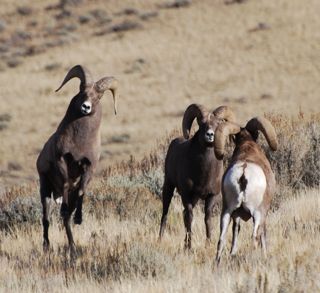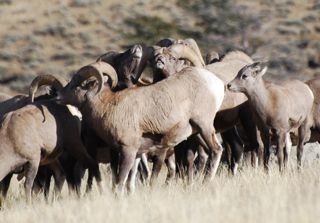 Yesterday I wrote about the graceful ballet of the bighorn—their scaling almost effortlessly high ridges and cliffs. Today, I spent three hours perched on a hillside watching another fascinating bighorn sheep behavior—the rut.
Yesterday I wrote about the graceful ballet of the bighorn—their scaling almost effortlessly high ridges and cliffs. Today, I spent three hours perched on a hillside watching another fascinating bighorn sheep behavior—the rut.
I had only planned to take a short hike today as I had much work to do, so I headed up the nearby shoulder of Mt. Everts for a little exercise. When I ascended a ridge, a large herd of bighorn appeared in the distance. So much for a quick hike—I settled down to watch. From my seat, I observed rams tussling for dominance and heard the accompanying gunshot of their clashing. Nearby, a large number of ewes and lambs grazed or napped unconcerned—I suppose they have become accustomed to these battles.
 As far as clashes go, the bighorn are pretty civilized. The rams “huddle,” in a group showing off their horns and sizing each other up. If a subordinate does not concede, a dominant ram may assume the “low stretch” stance that indicates power. Then suddenly, the two rams may surge toward each other and clash.
As far as clashes go, the bighorn are pretty civilized. The rams “huddle,” in a group showing off their horns and sizing each other up. If a subordinate does not concede, a dominant ram may assume the “low stretch” stance that indicates power. Then suddenly, the two rams may surge toward each other and clash.
Yet the incident ends very quickly and the rams may resume grazing next to each other immediately after the fight. I observed one ram settle down for a rest right in front of two sparring males.
 My favorite stance was the lip curl, a bighorn “funny face” made after a ram smells an ewe in order to determine her reproductive status. After the rams had fought for some time, the females moved near the huddle as if to say, “enough silly fighting!” Many of the eager males followed the ewes, strolling behind with their lips curled and heads lifted proudly in the air.
My favorite stance was the lip curl, a bighorn “funny face” made after a ram smells an ewe in order to determine her reproductive status. After the rams had fought for some time, the females moved near the huddle as if to say, “enough silly fighting!” Many of the eager males followed the ewes, strolling behind with their lips curled and heads lifted proudly in the air.
For all their abundance in Yellowstone, bighorn sheep in our country face many threats. Theodore Roosevelt is generally credited with bringing the sheep back from the brink of extinction in the early 1900s. Habitat erosion and climate change pose challenges for the bighorn. Exposure to livestock and even humans also put bighorns at the risk of contagious disease. As the park ranger notes in my prior post, this is one of the reasons approaching wildlife and being closer than 25 yards to an animal (100 yards for bears and wolves) is forbidden in the park.
I also took some video footage of the rut. Sorry-the wind is loud, but if you listen carefully at the end you'll hear the "gunshot" of two rams clashing.
